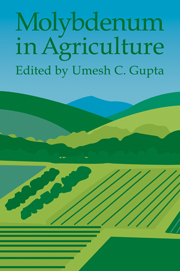Book contents
- Frontmatter
- Contents
- List of contributors
- Preface
- 1 Introduction
- 2 Chemistry and Mineralogy of Molybdenum in Soils
- 3 Distribution and Mobility of Molybdenum in the Terrestrial Environment
- 4 Biochemical Significance of Molybdenum in Crop Plants
- 5 Soil and Plant Factors Affecting Molybdenum Uptake by Plants
- 6 Analytical Techniques for Molybdenum Determination in Plants and Soils
- 7 Testing for Molybdenum Availability in Soils
- 8 Molybdenum Availability in Alkaline Soils
- 9 Deficient, Sufficient, and Toxic Concentrations of Molybdenum in Crops
- 10 Symptoms of Molybdenum Deficiency and Toxicity in Crops
- 11 Sources and Methods for Molybdenum Fertilization of Crops
- 12 Yield Responses to Molybdenum by Field and Horticultural Crops
- 13 Responses of Forage Legumes and Grasses to Molybdenum
- 14 Molybdenum and Sulfur Relationships in Plants
- 15 Molybdenum in the Tropics
- Index
3 - Distribution and Mobility of Molybdenum in the Terrestrial Environment
Published online by Cambridge University Press: 10 December 2009
- Frontmatter
- Contents
- List of contributors
- Preface
- 1 Introduction
- 2 Chemistry and Mineralogy of Molybdenum in Soils
- 3 Distribution and Mobility of Molybdenum in the Terrestrial Environment
- 4 Biochemical Significance of Molybdenum in Crop Plants
- 5 Soil and Plant Factors Affecting Molybdenum Uptake by Plants
- 6 Analytical Techniques for Molybdenum Determination in Plants and Soils
- 7 Testing for Molybdenum Availability in Soils
- 8 Molybdenum Availability in Alkaline Soils
- 9 Deficient, Sufficient, and Toxic Concentrations of Molybdenum in Crops
- 10 Symptoms of Molybdenum Deficiency and Toxicity in Crops
- 11 Sources and Methods for Molybdenum Fertilization of Crops
- 12 Yield Responses to Molybdenum by Field and Horticultural Crops
- 13 Responses of Forage Legumes and Grasses to Molybdenum
- 14 Molybdenum and Sulfur Relationships in Plants
- 15 Molybdenum in the Tropics
- Index
Summary
Introduction
Molybdenum (Mo) is an essential element for many plants and animals (Newton and Otsuka, 1980). Because of its chemical properties, Mo readily provides sites for reactions and catalysis in biochemical systems (Haight and Boston, 1973). It is therefore important to understand the processes that control the distribution, speciation, and behavior of Mo in the surficial environment. These processes will affect the bioavalability of Mo and ultimately its passage into the food chain.
In this chapter we discuss the distribution of Mo in the terrestrial environment and examine the factors that control its mobility.
General Chemical Properties of Molybdenum
Molybdenum is a transition element and a member of the 4d series of metals in period 5 of the periodic table. In elemental form, these metals generally are very hard and have high melting temperatures. They exhibit a wide range of oxidation states in their compounds, and they form bonds of high covalent character (Parish, 1977). Other elements that exhibit typical 4d chemistry include zirconium (Zr), niobium (Nb), technetium (Tc), ruthenium (Ru), rhodium (Rh), and palladium (Pd). Molybdenum is also a member of group VIB, along with chromium (Cr) and tungsten (W). There are many chemical similarities between Mo and W, but few similarities between Mo and Cr. The electronic configuration of the free atom of Mo is [Kr]4d55s1 Cotton and Wilkinson (1988) provided an in-depth discussion of the inorganic chemistry of Mo and stated that Mo reactions are among the most complex reactions involving any of the chemical elements.
- Type
- Chapter
- Information
- Molybdenum in Agriculture , pp. 23 - 46Publisher: Cambridge University PressPrint publication year: 1997
- 16
- Cited by



